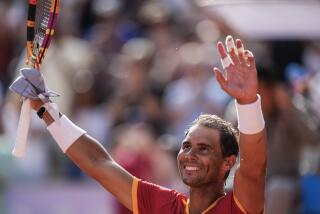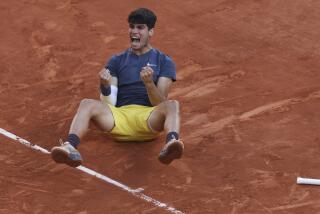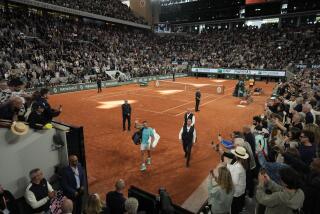Rafael Nadal wins his record 10th French Open title with rout of Stan Wawrinka

Sunday was a big day in the world of Sports. (June 12, 2017)
Reporting from PARIS â As he sat in front of a TV to watch last yearâs French Open final, sidelined by an injured left wrist, Rafael Nadal had no way to know for sure that he would return to the height of his powers.
For the second time in a row, the most important match at the most important clay-court tournament was being contested without him. As the 2017 edition at Roland Garros began, Nadalâs drought without a Grand Slam title was stretching to three full years.
âIt was difficult,â said Nadalâs uncle and coach, Toni. âWe were asking ourselves whether he would be able achieve this one more time.â
Turned out he could, and he did, as masterful as at any time. Overwhelmingly good from start to finish in Sundayâs final, and for the entire two weeks, Nadal won his record 10th French Open title with a 6-2, 6-3, 6-1 victory over 2015 champion Stan Wawrinka.
Call it a Perfect 10.
Or as the Nadals preferred: La Decima, Spanish for âThe Tenth.â
âI play my best at all events, but the feeling here is impossible to describe. Itâs impossible to compare it to another place,â Nadal said. âThe nerves, the adrenaline, I feel on the court are impossible to compare to another feeling. This is the most important event in my career.â
Not only did Nadal win every set he played in the tournament, he dropped a total of only 35 games, the second fewest by any man on the way to any title at a major tournament with all matches being best-of-five-sets in the Open era, which dates to 1968.
No other man or woman has won 10 championships at the same major in the Open era. Along with improving to 10-0 in finals at Roland Garros, Nadal increased his haul to 15 Grand Slam trophies, breaking a tie with Pete Sampras for second place in the history of menâs tennis, behind only rival Roger Federerâs 18.
It marked a stirring return to the top for Nadal at the site he loves the most: He is 79-2 at the French Open, 102-2 in all best-of-five-set matches on clay.
âHeâs playing the best heâs ever played. Thatâs for sure,â said Wawrinka, who had won 11 matches in a row on clay. âBut not only here.â
True. Nadal leads the tour with four titles and 43 match wins this season and will rise to No. 2 in the ATP rankings Monday.
Last year in Paris, Nadal withdrew before the third round, making the announcement while wearing a blue brace on his left wrist and resignation of his face. He couldnât bring himself to watch much of the rest of the 2016 French Open, he said, other than some doubles matches involving a good pal, and the singles final.
Finally back to full strength in the offseason, Nadal returned to work, reconstructing his forehand and redoubling his efforts to be elite.
âBack in November, when we were together, I told him he needed to get his forehand back, to improve a bit his serve, to put on a championâs face again,â said Uncle Toni, gripping his chin for emphasis, âand to become the No. 1 on clay again. And here, we had the confirmation.â
Nadal is no longer the 19-year-old who won the French Open in his debut in 2005, wearing long white pirate shorts, his flowing locks wrapped by a white headband, his sleeveless shirt revealing bulging biceps. Now he is 31, the shorts are shorter, the hair more closely cropped, the shirt has sleeves. His game? Better.
Nadal won again at Roland Garros in 2006, 2007 and 2008. After a fourth-round loss on bad knees in 2009, he grabbed five consecutive French Opens 2010-14. A quarterfinal loss in 2015 ended that run, and then came last yearâs injury.
On Sunday, the conditions were exactly to the liking of a guy who grew up on the island of Mallorca and still enjoys fishing in his down time. The sun was shining, there was barely a trace of cloud in the bright blue sky and the temperature was about 85 degrees (30 Celsius).
Wawrinka insisted a five-set semifinal win Friday over No. 1-ranked Andy Murray did not take anything out of him physically. The problem against Nadal, Wawrinka said, was more mental.
âHe puts this doubt in your head when you play against him,â said Wawrinka, who had been 3-0 in Grand Slam finals, including a victory over Nadal at the 2014 Australian Open.
After netting a forehand in the second set, Wawrinka pounded his racket on his head several times. Later, he spiked that piece of equipment, then mangled it, breaking it over his knee.
Nadal has that way of wearing down opponents. On this day, he was terrific. He won all 12 service games, made a mere 12 unforced errors and won 94 total points to Wawrinkaâs 57.
One area of significant improvement for Nadal is his serve. Once passable, it is now potent. Confronted with the matchâs first break point, 10 minutes in, he solved the predicament this way: service winner at 107 mph (173 kph), ace at 117 mph (189 kph), service winner at 120 mph (194 kph). That would be Wawrinkaâs lone break chance.
When the ball was in play, Nadal barely missed at all. His groundstrokes were delivered with loud, long grunts, echoing in the otherwise mostly silent Court Philippe Chatrier, filled with 15,000 or so souls too rapt to speak. They did let out a burst of claps and roars in the second set on one particularly exquisite display: Nadal sprinted to his left to chase Wawrinkaâs cross-court backhand wide of the doubles alley and whipped a forehand that curved around the net post and landed near a line for a winner.
Even Wawrinka applauded that one.
âNothing to say about today,â Wawrinka told Nadal during the trophy ceremony. âYou were too good.â
Indeed. Good as ever.
More to Read
Go beyond the scoreboard
Get the latest on L.A.'s teams in the daily Sports Report newsletter.
You may occasionally receive promotional content from the Los Angeles Times.










